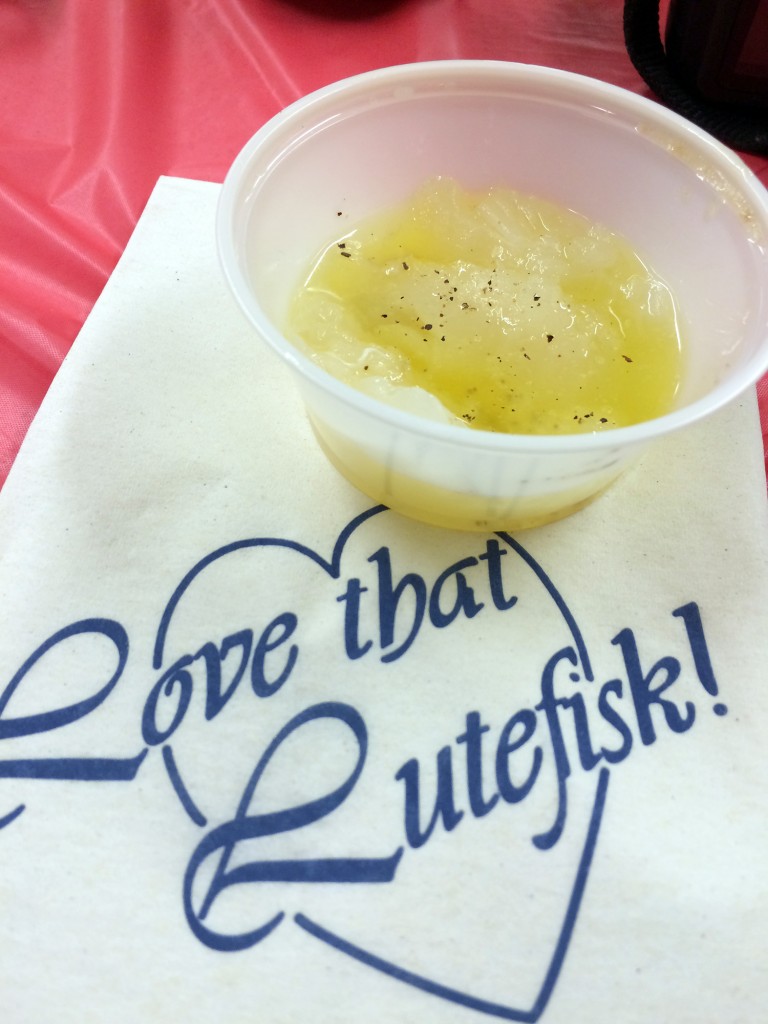Slimy, slippery, smelly and steeped in butter. It’s lutefisk and it was on the menu Saturday night.

 Slimy, slippery, smelly and steeped in butter. It’s lutefisk and it was on the menu Saturday night.
Slimy, slippery, smelly and steeped in butter. It’s lutefisk and it was on the menu Saturday night.
I had an idea for a unique way to cover Bowman Lutheran Church’s annual Lutefisk and Meatball Supper: I would try a piece of the lye-soaked cod and report my experience. I took to Facebook the night before asking if anybody had tried the ancient dish, and I was overwhelmed by a resounding, “Yuck.”
I didn’t fully prepare myself for what was to come.
I arrived to Bowman Lutheran Church early Saturday afternoon to get a glimpse of what locals in these parts had cautioned me about. I had only heard tales of the fishy dish, which is considered a delicacy to the Norwegian palate.
I met with Cooky Septon, one of the “masterminds” behind the evening’s lutefisk meal, who explained to me how the tradition began. It was an idea from her cousin, the late Clare Voight of Rhame. He had attended a lutefisk supper near Garrison and brought the idea down to Bowman County in 2007.
The first year, each fish was wrapped in cheesecloth to hold the pieces together, one of the most widely used cooking methods for the dish. Since Septon took over the lutefisk, along with Gerald and Gail Braaten, she opted for a more simple way of cooking the fish, just in water.
Septon, who is part Norwegian, ordered 175 pounds of the fish from Olsen Fish Co. in Minneapolis. It came pre-soaked in lye so the awfully smelly part of the ordeal had already occurred. From there, Septon began earlier in the week, soaking the fish in a mixture of salt and ice water for three nights.
Prior to cooking it at the church, it was soaked in water in large blue tubs in one of the church’s coolers.
Lutefisk, quite the acquired taste, begins with a long piece of stockfish—most commonly cod—that is soaked in a lye solution for several days to rehydrate it. Lye is a strongly alkaline solution, especially of potassium hydroxide, used for washing or cleansing.
Once the fish is soaked in lye, it becomes caustic, meaning it’s able to burn or corrode organic tissue by chemical action.
It is rinsed with cold water to remove the lye, then boiled or baked, and then served with butter, salt and pepper.
Septon said people come from all over to attend the church’s annual lutefisk dinner. A circuit of people desiring the often hard to find dish attend such dinners around the state each year simply for a piece, or two, of the cultural dish.
Olsen Fish Co. labeled itself as the world’s largest lutefisk producer using only genuine Norwegian stockfish. Much of the Olsen lutefisk comes from the Norwegian town of Alesund.
According to Olsen’s website, lutefisk translated means lyefish, which refers to the early process of soaking where a lye solution made of birch ashes was used in the luting process.
In many Norwegian homes, lutefisk takes the place of the Christmas turkey.
Septon said she was practically raised on the fish, eating it every Christmas Eve. Now, however, she passes on the fishy dish.
No one is quite sure where and when lutefisk originated, according to an article about the fish dish by the Smithsonian magazine. Both Swedes and Norwegians claim it was invented in their country.
In the Sagas of the Norwegian Kings, from the 12th century, Snorre wrote about King Oystein building fishing shanties in Lofoten. Lofoten was the most important spawning ground for the cod, and for centuries Norwegian fisherman have hauled in huge catches of mature cod in January to April spawning period. The age-old adventure continues, creating the foundation for human existence and sustenance along with the entire Norwegian coast.
Stockfish is probably one of Norway’s oldest trading commodities. It has been used for trading with foreign countries for centuries, along with skins and furs.
In Viking times, stockfish was both a main part of the diet, and a trading commodity on long voyages.
After I learned about the dish I was about to eat, I understood its cultural significance. I didn’t want to offend any Norwegians in the room if I happened to show overt signs of disgust when I ate the fish.
Unfortunately, I would find that was inevitable.
I grabbed a plate of meatballs, mashed potatoes and vegetables—the more delectable choice for the supper—and kindly asked if I could try a sample of the lutefisk. I again was questioned, “Are you sure?”
I swallowed my fear.
I looked down at the small piece of translucent cod, hardly recognizable in a swirling cup of melted butter. The smell was what you’d expect, quite fishy. I grabbed a plastic fork, took a heaping portion and slowly lifted it towards my mouth.
My reaction was all caught on video.
With deliberate fastness, I rested the fish on my tongue. My eyes began to narrow as the lutefisk’s flavor reached my taste buds. To my surprise, there wasn’t much of a flavor, just an overwhelming taste of butter.
But wait…
Yes, there it was, what people familiar with the fish tried to avoid. Not too much of a displeasing taste, but a dreadful texture that made me grimace. I immediately regretted putting the fish into my mouth. It was like a warm Jell-O.
What? Who eats warm, fish Jell-O?
By that time, the lutefisk had reached the back of my mouth, unfortunately about to make its way down my throat and into my stomach. I cringed a bit more distinctly.
I didn’t attempt to chew. I thought the butter would be good enough lubricant for the fish to simply roll down my throat, but it seemed to lump up in the back and just hang out there, sort of teasing me. Not a big fan of fish to begin with, the abundant cod taste started tugging on my gag reflex. No, I thought, please don’t let me throw up on video and in this big crowd of people.
I swallowed hard and the fish finally left its place in my mouth.
I survived, that is, until the aftertaste arrived. It was like I had eaten it all over again.
But then I took a hearty swig of water and that seemed to properly wash it down. I followed that with a helping of mashed potatoes.
I exhaled with relief. It was over.
Here’s the video…





